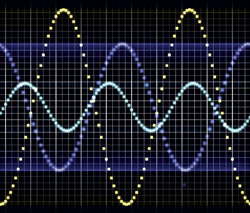ECE 3250 Contents
Course Description
Syllabus
Lecture Notes and Handouts
Homework and Exams
Note: Projects and Labs are not available for this course.
Syllabus
- Numbers, sets, and mappings:
What are numbers? Description of how to construct real numbers from natural numbers through integers and rationals. Sets and mappings — injective, surjective, and bijective mappings; cardinality; etc. - Working with integers:
Prime numbers and prime factorization. Applications to cryptography: Hellman-Diffie-Merkle, Shamir’s 3-pass protocol, and RSA encryption. - Working with real and complex numbers:
Sequences and limits including Cauchy sequences. Infinite series and distinction between summability and absolute summability. Upper and lower bounds, mins and maxes, sups and infs, limsup and liminf. - Discrete-time signals and convolution:
Discrete-time signals as mappings from integers to real or complex numbers. Right- and left-sided signals and finite-duration signals. l 1 , l 2 , and l ∞ signals along with l 1 ⊂ l 2 ⊂ l ∞. Discrete-time convolution including sufficient conditions for existence of two signals’ convolution. - Discrete-time LTI systems:
A system as a shift-invariant linear mapping from some subspace of the set of all discrete-time signals to the set of all such signals. Impulse response and conditions for representability of system mapping as convolution of input with impulse response. FIR systems. Causality and BIBO stability and their characterizations in terms of impulse response. - Continuous-time signals and convolution:
Continuous-time signals as mappings from reals to real or complex numbers. Right- and left-sided signals and finite-duration signals. L 1 , L 2 , and L ∞ signals along with failure of containments between these spaces. Continuous-time convolution including sufficient conditions for existence of two signals’ convolution - Continuous-time LTI systems:
A system as a shift-invariant linear mapping from some subspace of the set of all continuous-time signals to the set of all such signals. Continuous-time impulses. Impulse response and conditions for representability of system mapping as convolution of input with impulse response. Causality and BIBO stability and their characterizations in terms of impulse response. - Periodic signals and Fourier series:
Inner-product spaces, Hilbert space, complete orthonormal sets in separable Hilbert space, and orthogonal expansion in terms of such a set. The set of periodic signals having a given To as a period as an inner-product space (subspace of L 2 ). Fourier series as orthogonal expansions of these signals in terms of a particular complete orthonormal set. Intuition about Fourier series as providing spectral descriptions of periodic signals. - Fourier transforms:
Existence criteria for Fourier transforms. Fourier transforms as spectral descriptions of non-periodic signals. Frequency responses of continuous-time LTI systems and criteria for existence thereof. The frequency-selective filter idea. Pure complex sinusoids as “eigen-inputs” of continuous-time LTI systems. - The DTFT and Sampling:
Existence criteria for DTFT. Frequency responses of discrete-time LTI systems and criteria for existence thereof. DTFT of sampled version of a continuous-time signal in terms of that signal’s Fourier transform. Interpolation of 1 2 discrete-time signals into continuous-time signals. Three versions of the Sampling Theorem with intuition-building examples. - The DFT and FFT:
The DFT along with three applications (computing ordinary convolutions of finite-duration discrete-time signals, block convolution, and frequency sampling design of discrete-time filters). The decimation-in-time FFT for discrete-time finite-duration signals with duration a power of 2. - The z-transform:
A careful treatment with a full discussion of regions of convergence and a lot of borderline cautionary examples. BIBO stability of causal LTI systems with rational z-transforms in terms of poles. Signal flow graphs. Unilateral z-transform as a tool for solving linear constant-coefficient difference equations. - The Laplace transform:
A careful treatment with a full discussion of regions of convergence and a lot of borderline cautionary examples. BIBO stability of causal LTI systems with rational Laplace transforms in terms of poles. Unilateral Laplace transform as a tool for solving linear constant-coefficient differential equations. - The singular-value decomposition:
A full treatment for arbitrary non-square, non-full rank matrices. The Moore-Penrose pseudo-inverse and using SVD to solve linear least-squares problems. As time permits, an introduction to Principal Component Analysis. - Elementary convex analysis:
Haven’t had time for this yet, but I’d like to cover basic definitions and the Separating Hyperplane Theorem. - Introduction to wavelets:
Again, haven’t had time for this one yet. If we get to it this year, it’ll probably be after the DFT and FFT section.
